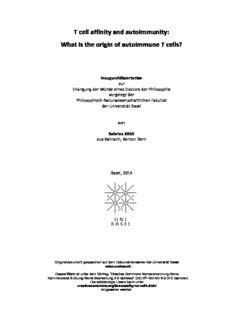Table Of ContentT
cell
affinity
and
autoimmunity:
What
is
the
origin
of
autoimmune
T
cells?
Inauguraldissertation
zur
Erlangung
der
Würde
eines
Doktors
der
Philosophie
vorgelegt
der
Philosophisch-‐Naturwissenschaftlichen
Fakultät
der
Universität
Basel
von
Sabrina
Köhli
aus
Kallnach,
Kanton
Bern
Basel,
2014
Originaldokument gespeichert auf dem Dokumentenserver der Universität Basel
edoc.unibas.ch
Dieses Werk ist unter dem Vertrag “Creative Commons Namensnennung-Keine
Kommerzielle Nutzung-Keine Bearbeitung 3-0 Schweiz” (CC BY-NC-ND 3-0 CH) lizenziert.
Die vollständige Lizenz kann unter
creativecommons.org/licenses/by-nc-nd/3.0/ch/
eingesehen werden.
Genehmigt
von
der
Philosophisch-‐Naturwissenschaftlichen
Fakultät
auf
Antrag
von
Prof.
E.
Palmer
Prof.
A.
Rolink
Basel,
den
10.12.2013
Prof.
Dr.
Jörg
Schibler
1"
"
"
"
"
“Nothing in life is to be feared, it is only to be understood.
Now is the time to understand more, so that we may fear less.”
Marie Curie
(1867-1934)
"
"
"
" "
2"
"
"
"
"
to#my#parents#
" "
Namensnennung-Keine kommerzielle Nutzung-Keine Bearbeitung 3.0 Schweiz
(CC BY-NC-ND 3.0 CH)
Sie dürfen: Teilen — den Inhalt kopieren, verbreiten und zugänglich machen
Unter den folgenden Bedingungen:
Namensnennung — Sie müssen den Namen des Autors/Rechteinhabers
in der von ihm festgelegten Weise nennen.
Keine kommerzielle Nutzung — Sie dürfen diesen Inhalt nicht für
kommerzielle Zwecke nutzen.
Keine Bearbeitung erlaubt — Sie dürfen diesen Inhalt nicht bearbeiten,
abwandeln oder in anderer Weise verändern.
Wobei gilt:
Verzichtserklärung — Jede der vorgenannten Bedingungen kann aufgehoben werden,
sofern Sie die ausdrückliche Einwilligung des Rechteinhabers dazu erhalten.
Public Domain (gemeinfreie oder nicht-schützbare Inhalte) — Soweit das Werk, der
Inhalt oder irgendein Teil davon zur Public Domain der jeweiligen Rechtsordnung gehört,
wird dieser Status von der Lizenz in keiner Weise berührt.
Sonstige Rechte — Die Lizenz hat keinerlei Einfluss auf die folgenden Rechte:
o Die Rechte, die jedermann wegen der Schranken des Urheberrechts oder aufgrund
gesetzlicher Erlaubnisse zustehen (in einigen Ländern als grundsätzliche Doktrin
des fair use bekannt);
o Die Persönlichkeitsrechte des Urhebers;
o Rechte anderer Personen, entweder am Lizenzgegenstand selber oder bezüglich
seiner Verwendung, zum Beispiel für Werbung oder Privatsphärenschutz.
Hinweis — Bei jeder Nutzung oder Verbreitung müssen Sie anderen alle
Lizenzbedingungen mitteilen, die für diesen Inhalt gelten. Am einfachsten ist es, an
entsprechender Stelle einen Link auf diese Seite einzubinden.
Quelle: http://creativecommons.org/licenses/by-nc-nd/3.0/ch/ Datum: 12.11.2013
3"
Table&of&contents&
!
Abbreviations&.....................................................................................................................&5"
Summary&..............................................................................................................................&6"
Introduction&........................................................................................................................&9"
1" Innate&and&Adaptive&Immunity&..............................................................................&9"
2" T&cell&receptor&complex&and&signaling&..............................................................&10"
3" T&cell&Development&and&Central&Tolerance&.....................................................&12"
3.1" Positive&and&Negative&Selection&...............................................................................&15"
3.2" Signaling&molecules&involved&in&negative&selection&..........................................&18"
3.3" Measurement&of&TCRIpMHC&Affinity&.......................................................................&19"
3.4" Peripheral&Tolerance&...................................................................................................&21"
4" T&cell&Activation&........................................................................................................&22"
4.1" General&aspects&of&CD8&T&cell&activation&................................................................&22"
4.2" Asymmetric&T&cell&division&.........................................................................................&23"
5" Murine&Models&for&Autoimmunity&......................................................................&24"
5.1" Transgenic&mice&as&a&model&to&study&autoimmune&diabetes&.........................&24"
5.2" Ovalbumin&and&APLs&for&the&specific&activation&of&T&cells&...............................&27"
5.3" LPS&and&Listeria(monocytogenes&as&tools&to&activate&innate&immunity&.......&28"
6" Materials&and&Methods&...........................................................................................&30"
6.1" Reagents&...........................................................................................................................&30"
6.1.1" Solutions"and"media"............................................................................................................."31"
6.1.2" Antibodies"................................................................................................................................."32"
6.1.3" Peptides"....................................................................................................................................."33"
6.1.4" Tools"for"Glucose"measurements"...................................................................................."34"
6.1.5" Instruments".............................................................................................................................."34"
6.1.6" Software"....................................................................................................................................."34"
6.1.7" Generation"of"OVA"variant"transgenic"mice"..............................................................."35"
6.1.8" Generation"of"double"transgenic"mice".........................................................................."36"
6.2" Histochemistry&...............................................................................................................&37"
6.2.1" Preparation"of"frozen"tissue"sections"............................................................................"37"
6.2.2" Hematoxilin/Eosin"(H&E)"staining"................................................................................"37"
6.2.3" Immunohistochemistry"(IHC)".........................................................................................."37"
6.3" T&cell&isolation&from&lymphnodes&and&B&cell&isolation&from&spleen&.............&38"
6.4" Adoptive&T&cell&transfer&and&immunization&with&peptide/LPS&......................&39"
6.5" Tetramer,&surface&antibody&staining&and&flow&cytometry&...............................&39"
6.6" Intracellular&cytokine&detection&..............................................................................&39"
6.7" Killing&assay&....................................................................................................................&40"
6.8" Culturing&of&Listeria(monocytogenes(and&infections&..........................................&40"
6.9" Generation&of&radiation&bone&marrow&chimeras&...............................................&40"
6.10" Urine&and&blood&glucose&measurements&............................................................&41"
6.11" Data&analyses&...............................................................................................................&41"
Thesis&Objectives&.............................................................................................................&42"
7" Results&and&Discussion&...........................................................................................&43"
7.1" Part&I,&Immunity&Article&..............................................................................................&43"
4"
7.2" Part&II,&Manuscript&........................................................................................................&56"
7.3" Part&III,&Supplementary&Figures&...............................................................................&92"
7.4" General&Discussion&.......................................................................................................&97"
References&......................................................................................................................&100"
Acknowledgments&........................................................................................................&112"
Curriculum&Vitae&..........................................................................................................&114"
"
"
"
"
" "
5"
Abbreviations!
"
aa# # # # amino#acid#
Ab# # # # Antibody#
APC# # # # Allophycocyanine#
APCs# # # # Antigen#Presenting#Cells#
APC6Cy7# # # Allophycocyanine6Cyanine#dye#7#
APL# # # # Altered#Peptide#Ligand#
A700# # # # Alexa#Fluor#700#
BB#rat# # # # Bio6Breeding#Rat#
BHI# # # # Brain#Heart#Infusion#
CD# # # # Cluster#of#Differentiation#antigen#
CFU# # # # Colony#Forming#Units#
cTEC# # # # cortical#Thymic#Epithelial#Cell#
CTL# # # # Cytotoxic#T#Lymphocyte#
DC# # # # Dendritic#Cell#
DMEM## # # Dulbecco’s#modified#eagle#medium#
DNA# # # # Deoxyribonucleic#Acid#
DP# # # # Double#Positive#(CD4+CD8+)#
FACS# # # # Fluorescence#Activated#Cell#Sorting#
FCS# # # # Fetal#Calf#Serum#
FITC# # # # Fluorescein#isothiocyanate#
ITAM# # # # Immunoreceptor#Tyrosine#Activation#Motif#
K ## # # # Dissociation#Constant#
D
mAb# # # # monoclonal#Antibody#
MFI# # # # Mean#Fluorescence#Intensity#
mTEC# # # # medullary#Thymic#Epithelial#Cell#
NOD# # # # Non6Obese#Diabetic#Mouse#
PAMPs## # # Pathogen#associated6molecular#patterns#
PBS# # # # Phosphate#Buffered#Saline#
PCR# # # # Polymerase#Chain#Reaction#
PE# # # # Phycoerythrin#
PE6Cy7## # # Phycoerythrin6Cyanine#dye#7#
PerCP# # # # Peridinine#Chlorophyll#Protein#
pMHC# # # # peptide/Major#Histocompatibility#Complex#
RAGs# # # # Recombination6activation#genes#
RT# # # # Room#Temperature#
RPMI# # # # Roswell#Park#Memorial#Institute#1640#Medium#
PRR# # # # Pattern#Recognition#Receptor#
SA# # # # Streptavidin#
SP# # # # Single#Positive#(CD4+#or#CD8+)#
TCR# # # # T#Cell#Receptor#
Tcra# # # # T#cell#receptor#α#locus#
Tcrb# # # # T#cell#receptor#β#locus#
tg# # # # transgenic#
TLR# # # # Toll#like#receptor#
T1D# # # # Type#1#Diabetes#(Autoimmune#Diabetes)#
OD# # # # Optical#Density#
" "
6"
Summary!
"
T#cell#receptor#affinity#for#self6peptide/MHC#ligand#has#a#well#established#role#in#
thymic#selection.#Above#a#certain#affinity#threshold#(K #≤#6#μM)#a#developing#CD8+#T#
D
cell#is#negatively#selected,#while#below#this#threshold#it#is#positively#selected,#and#no#
binding#results#in#die#by#neglect.#How#TCR#affinity#contributes#to#the#induction#of#
autoimmune#pathology#remains#poorly#understood.#
In#the#first#part#of#my#thesis,#I#examined#the#role#of#TCR#affinity#in#peripheral#T#cells#
activation#and#the#maintenance#of#peripheral#tolerance.#To#do#this,#I#make#use#of#the#
RIP6OVA#experimental#autoimmune#diabetes#model.#In#RIP6OVA#mice,#OVA#peptide#
(SIINFEKL)#is#under#the#control#of#the#rat#insulin#promoter#(RIP6OVA)#and#is#expressed#
in#both#the#pancreas#and#the#thymus.#Diabetes#can#be#induced#in#RIP6OVA#mice#
following# adoptive# transfer# of# OVA6specific# CD8+# T# cells# (OT6I# T# cells)# and#
immunization#with#OVA#peptide#and#lipopolysaccharide#(LPS).#To#determine#the#role#
of# TCR# affinity# in# diabetes# induction,# mice# were# immunized# with# OVA# peptide#
variants#that#span#the#threshold#between#positive#and#negative#selection.#Only#mice#
receiving#high#affinity#peptides#(above#the#threshold#for#inducing#negative#selection)#
were#able#to#induce#diabetes.#These#findings#were#confirmed#by#histology#which#
revealed# highly# infiltrated# pancreatic# islets# only# in# mice# immunized# with# above#
threshold#ligand.#In#addition,#higher#affinity#ligands#induced#stronger#proliferation,#
activation# marker# upregulation# and# MAP# kinase# activation.# Increasing# the#
immunization#dose#of#below#threshold#ligand#was#not#sufficient#to#induce#disease#
although#additional#experiments#confirmed#that#below#threshold#activated#T#cells#
were#not#anergic.#These#findings#indicate#that#the#affinity#threshold#established#in#
the#thymus#is#maintained#in#the#periphery.#In#addition,#we#identified#asymmetric#
division#as#a#mechanistic#link#between#TCR#affinity#and#the#induction#of#autoimmune#
pathology.#T#cell#priming#with#above6threshold#ligand#promotes#sustained#contact#
with# antigen# presenting# cells# (APCs),# which# promotes# strong# T# cell# polarity# and#
asymmetric#cell#division.#Asymmetric#division#results#in#the#generation#of#“proximal”#
daughter#cells#capable#of#undergoing#sustained#proliferation#and#differentiation#into#
short6lived#effector#T#cells.#High6affinity#TCR6pMHC#interactions#also#promoted#T#cell#
upregulation#of#VLA64,#an#integrin#important#for#infiltration#into#target#tissue.#In#
7"
contrast,# T# cells# activated# by# below6threshold# antigens# underwent# symmetric#
division,#leading#to#abortive#clonal#expansion#and#failure#to#fully#differentiate#into#
tissue6infiltrating#effector#T#cells.##
#
In#the#second#part#of#my#thesis,#I#addressed#the#origin#of#self6reactive#T#cells.#I#was#
particularly#interested#to#understand#the#impact#of#TCR#affinity#on#1)#the#efficiency#
of#negative#selection#in#the#thymus;#2)#the#priming#of#a#pathologic#T#cell#response;#
and#3)#the#ability#of#a#T#cell#to#destroy#self6antigen#expressing#target#cells.#To#address#
these#questions#I#made#use#of#newly#generated#transgenic#mouse#lines#expressing#
OVA6variant#proteins#with#altered#affinities#for#the#OT6I#TCR#under#the#rat#insulin#
promoter#(RIP6variant#mice).#
To#assess#the#efficiency#of#negative#selection#in#RIP6variant#mice,#I#crossed#them#with#
OT6I#TCR#transgenic#mice.#All#double#transgenic#mice#developed#severe#diabetes#
early#after#birth,#suggesting#that#there#were#too#many#OT6I#T#cells#in#this#system.#As#
an# alternative# approach,# I# generated# radiation# bone# marrow# chimeras# (further#
addressed#below).#
To#assess#the#role#of#TCR#affinity#in#the#priming#of#a#pathologic#T#cell#response,#I#
needed#a#model#in#which#the#affinity#for#priming#is#variable.#I#adoptively#transferred#
OT6I#T#cells#into#RIP6variant#transgenic#mice#followed#with#Listeria(monocytogenes#
expressing#OVA#(Lm6OVA)#(in#the#case#of#transfer#into#RIP6OVA#mice)#or#variant#
peptide#(depending#on#variant#expression#in#host#mice).#Using#this#approach#I#found#
that#T#cells#activated#with#threshold#and#below#threshold#ligands#are#poor#inducers#
of#effector#T#cell#differentiation,#and#therefore#comprise#a#low#risk#for#autoimmunity.##
To#investigate#the#impact#of#TCR#affinity#for#target#tissue#antigen#on#the#induction#of#
autoimmune#pathology,#I#used#a#model#in#which#priming#efficiency#is#strong#but#the#
antigen# affinity# of# the# target# tissue# is# variable.# OT6I# T# cells# were# adoptively#
transferred#into#RIP6OVA#variant#mice#and#challenged#with#Lm6OVA.#Diabetes#was#
strongly#induced#in#mice#expressing#both#high#affinity#and#threshold#antigens#in#the#
pancreas.#In#contrast,#mice#expressing#below#threshold#ligand#remained#diabetes#
free#even#after#high#numbers#of#OT6I#T#cells#were#transferred#(107).#These#data#
indicate#that#threshold#and#below#threshold#target#cells#comprise#a#low#risk#for#
autoimmunity.#
Description:How# TCR# affinity# contributes# to# the# induction# of# Ondřej,#for#his#helpful#scientific#input#and#his#unbreakable#sense#of#integrity.#.

